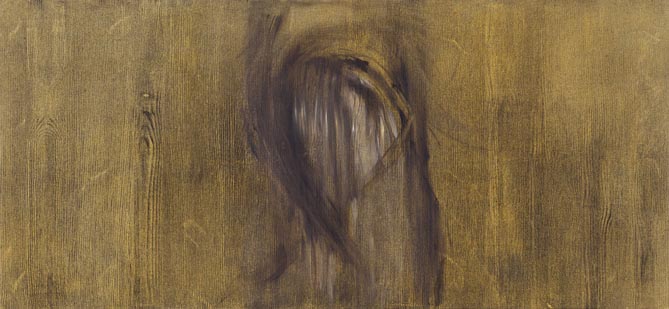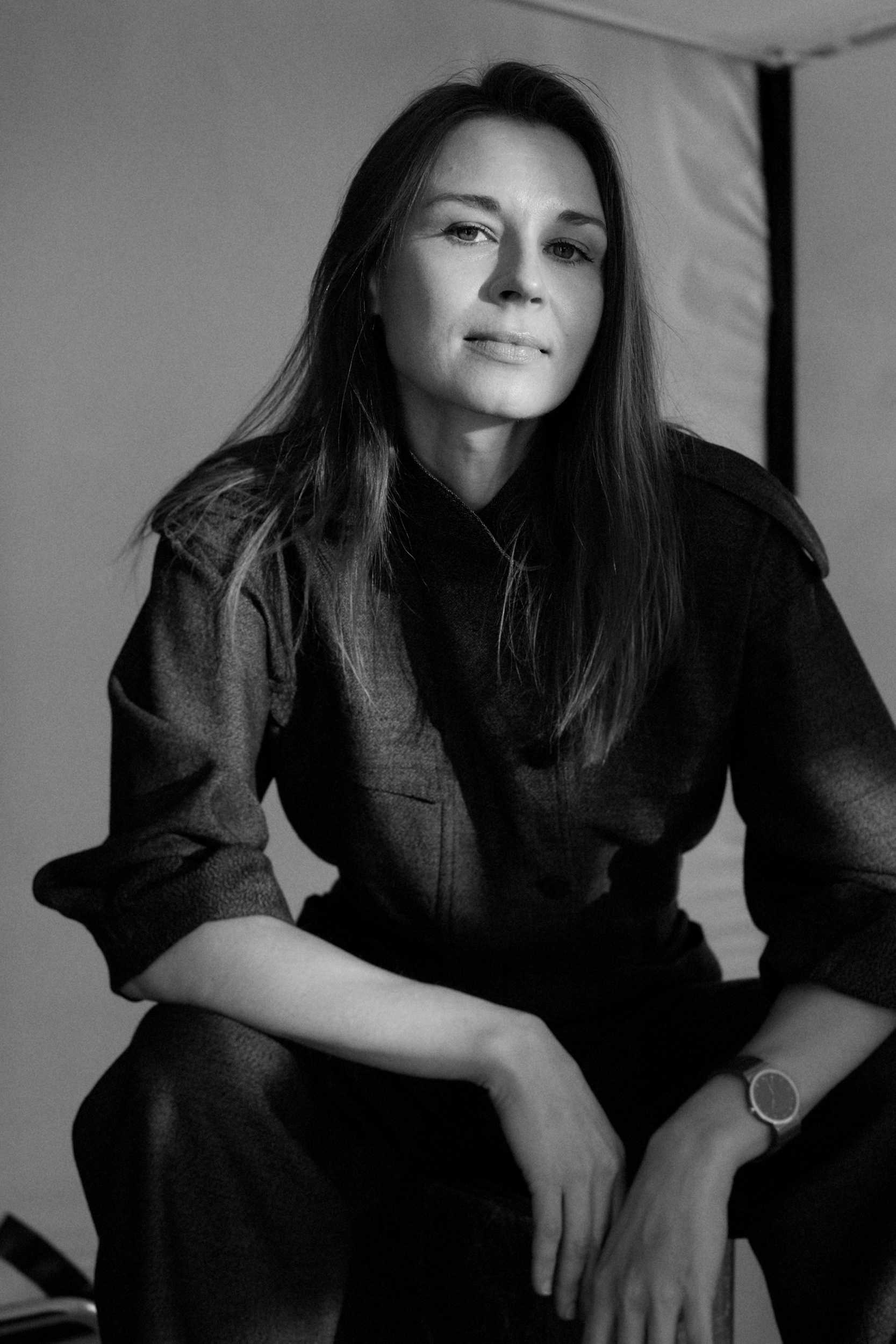THE TOUCH OF THE GAZE
Mika Hannula: Your exhibition includes both representational and characteristically non-representational works, albeit the dividing line between the two is organically unstable, and interlinks and interweaves them. One thing worth noting, in any case, is the way that in these works you have, in a sense, returned to figuration – but still very much in your own way and on your own terms. What is the background to and significance of this painterly shift?
Eeva-Riitta Eerola: It seemed like a good idea at this point to take a look back at what I’ve been doing, and to mix some of the old ways of painting with the newer working methods. It also felt simply refreshing to make variations on my own handiwork and on the tempo of painting. Thinking of the exhibition as a whole, I find that the different modes of representation offer complementary modes of reading for taking in the works – for example, having a purely painterly gesture juxtaposed with the figuration in another work.
MH: The whole thing includes two quite sizeable, dark, independent yet coherent works; the duo of works, In Sight, which becomes an event, a painting in relation to the landscape and to a landscape-like opening up of possibilities. What were the starting points for this pair of works, and what does the landscape mean to you specifically in a painterly sense?
E-R E: In this process I wanted to deal with space more concretely than I have done in recent years. While, in contrast, the black ground has been a part of my working process for some time – I am fascinated by its potential for filling up a picture from the inside. By that I mean that a dark ground creates its own distinctive feeling, that it contains more than the painting shows, and the gaze begins to seek out complementary aspects to the things shown. Of course, also present in the black is a powerful charge and drama, almost to the point of banality. This being the case, the works set off naturally from these starting points: I wanted to view the landscape through the black, a bit like darkness lit up by a pocket torch.
The paintings in question are genuinely independent works, but, when juxtaposed, they seek definition from each other, and serve as examples of the shift you mentioned in the degree of representation, and of ways of reading that open up and complement each other through it. The collage-likeness – the decomposition and reconstruction of the picture – plays a major role in my working process, on the level of both concepts and working methods. Nevertheless, in these works I use it to dismantle a single pictorial motif, or space, instead of this being about interlocking pictorial building blocks that constitute a new whole.
In a landscape, at least in relation to this exhibition, what is at stake is mostly specifically a space or a view. My own approach to the landscape is bound up with a contemplation of the organic versus the artificial and, on the other hand, of the human way of creating definitions like this, and further, to the human need to control nature. Equally, contemplation of the landscape or the concept of nature and, conversely, of painting itself is also linked in some of the works with the facsimile painting that I have, for example, applied in the imitation of a wood surface. I was interested to think about where it fits in, does it show up as the material of the surface or the image, what is the space like, and how does it compare with the other pictorial motifs in the exhibition?
MH: The exhibition’s clearly more figurative direction is represented by a work called Subject. Will you say a bit more about the background to the work, and about what you think is “happening” in it?
E-R E: That painting combines two of the important themes of the exhibition as a whole – the wood-like surface and a reference to the human being, here via hair. The figurativeness of these two aspects, nevertheless, remains incomplete, more specifically on the level of a reference. The “event” in the work in question is, to my mind, connected with the way a painting generally facilitates the experiential side of things, and numerous simultaneous modes of reading.
MH: What was it in this particular work, Subject, and in the process of working on it, that you recognized and intuited? Was there something new, different and unexpected in it, with and through the practical process of making it?
E-R E: Concretely in working on it, the wooden ground took longer, whereas the figure came about quite rapidly with a momentary decision. But in the mingling of these elements, or in the way the figure breaks up or is mirrored, something surprising happened that was worth preserving and developing further. The best things in a painting usually come about unplanned or, rather, you have to manage to stay alert in order to pick up on good accidents.
MH: We are talking about the painting happening, about how it is actualized. We are talking about how things become visible, or about how they are revealed. Earlier on in this conversation you have used the following interesting, everyday-life figure of speech: like torchlight in a forest. What does that mean and where does it take us?
E-R E: In this context, I mean concretely the way the beam of light reveals the objects that it strikes, and in the large works mentioned previously the landscape is also revealed in that way, because of the black ground. The relationship between light and dark is, of course, fascinating – the way that I get caught up in the “reality” revealed by the light, and from what it excludes there comes something other, something undefined. But yes, in any case, I think that this metaphor is applicable to other things when we are speaking about painting, specifically to the way that things come about in its space or become visible through it.
MH: To what extent is that “coming about” and “happening” a matter of chance, how systematically has it been worked on, realized?
E-R E: Painting, at least for me, at its best makes it possible to work consciously and intuitively at the same time. But, of course, it is terribly hard to let yourself truly be guided by intuition, so that your mind does not try to control the situation. Generally, following situations when the material behaves in an unexpected way, you get to go in an unpredictable direction, and that in turn awakens insights for the subsequent solutions.
MH: It seems that you want to emphasize plurality and the diversity of ways of experiencing and reading the works. Why? In the same way as verbalizing something always involves focusing on a particular interpretation, but by no means necessarily deciding on this and shutting the process down, correspondingly, the gaze is directed in line with our own background, hopes and needs; it comes from somewhere and goes somewhere, not from just anywhere or anyhow. So: diversity, how and in what sense?
E-R E: Because the possibility for multiple interpretations is an area of painting that interests me. This is, of course, bound up with the viewer’s own interpretation, “the personal nature of the gaze”, which, as I understand it, is what you are talking about, but also the fact that the information contained in a painting is not linear, rather, the same work can contain many “propositions”. A simplified example: in the work we mentioned, Subject, I see it as being about simultaneous presence and absence, or that my own position varies in relation to the figure and the surface; is the figure in front of me, or am I between it and the surface?
MH: The gaze as an action, an event, and always and endlessly an interaction. We are returning to the roots of phenomenology, to basic questions about the perception of everyday life and our environment – along with the capacity of a painting to be present, to breathe and to create interaction. How do you yourself approach the question of the touch of the gaze and the narrowing, the concentration, of the gaze in the painting?
E-R E: What I find most interesting in painting is specifically its capacity for being readable through looking, (even) without a verbal reading. Many kinds of information can be incorporated into a painting without you yourself necessarily being aware of what is going on, but just knowing about the presence of something that needs exploring. In this conversation, I am, in fact, again noticing the complexity of my relationship with words in the context of my paintings. I in no way want to mystify or unnecessarily complicate painting, but somehow I would like to keep the making process far away from words. I suppose this is linked with the fear that, if I chew over what I do too much, on the level of words, it seems to disrupt something, and it eats away at my own interest in carrying on with the painting.
MH: What is the spatial experience that you are seeking, and which is important to you in the exhibition space itself?
E-R E: The almost clinical whiteness of the gallery space tempted me to use a dark, broken colour scale, I believed it would act as a good counterpart to the way that the works are reaching towards something more organic. If we think about creating a rhythm in the hanging, what I find interesting is the way that the structures of the space affect the dramaturgy of looking – are the works looked at through something, which ones are seen at the same time, which one do people go back to. I suppose this allows for subtle shifts, which affect the experiencing of the serial works in particular.
MH: The touch of the gaze, its lingering, questing intensity. The sensory nature of the painting, the pleasure of the encounter. That is very much precisely what I see and experience in these works. If we reverse the set-up, when and where did you yourself last experience the opening up of the possibilities of the painting?
E-R E: Maybe it could also apply to the way that, when observing the work of colleagues, you see things slotting into new grooves, and, of course, fortunately, in your own painting, too, you sometimes have one of those good moments when the medium seems of its own accord to take the work in an unexpected direction. But, if we are talking about exhibitions, then, for example, Ellen Gallagher’s exhibition at the Sara Hildén Art Museum last year was a special experience for me. I find her works, both extremely human and, yet, something in them evokes a feeling that they have somehow come about of their own accord, as if in another reality. I think that exhibition was also a splendid example of how the architecture of the space, with all its details, and the visual quality of the works come together and jointly add yet another new level to the viewing experience.
27.10.2014


Share this exhibition